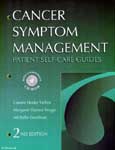Cancer Symptom Management
Authors: Connie Henke Yarbro, Margaret Hansen Frogge, Michelle Goodman OncoLink Rating: |
Cancer patients can often be affected by a wide array of symptoms as a result of either their disease or its treatment. These patients are often left to manage their symptoms at home, without knowing exactly how. The three editors of this text are all oncology nurses, and know from experience how frustrating it can be for their patients to manage their symptoms with minimal guidance. Their first-hand experience provided the impetus to put together this collection of guides, in order to help cancer patients understand and take care of their myriad symptoms.
This book contains 85 patient teaching guides and numerous other patient education handouts; they were all written by oncology nurses. These guides can be customized for each individual patient to use: additions and changes should be made to them by one's health care provider, then they can be used by the individual patient. A CD-ROM is provided to allow health care providers to print out these guides for their patients.
This collection of guides provides an invaluable tool for health care providers and their patients, as a result of both excellent content and style. The text's content is extensive; it is very comprehensive. The book's content is divided into seven parts. Each part addresses symptoms that are related. For example, one part is dedicated to symptoms of disturbances of comfort, and addresses symptoms such as dyspnea and fatigue. Another part covers symptoms of alterations in nutrition, and addresses symptoms such as dysphagia and nausea. There is also a part on symptoms of disturbances of protective mechanisms, and it addresses symptoms such as alopecia and bleeding
The style of the book is as valuable as its content. It is easy to read, and well organized. Within the seven parts of the book, a separate section is devoted to each particular symptom. The symptom is always first defined, and then learning needs are discussed (such as recommended reading materials, describing what conditions may aggravate the symptom, etc.). The section will then address prevention and management. This explains to the patient what medicines to take as prescribed by one's physician, and gives advice such as resting, using heating pads, and so forth. Each section ends with follow-up advice, such as how to keep records of your symptoms to show your doctor or nurse, and when to be concerned and contact your doctor. This organization of symptom management can greatly enhance communication between health care providers and their patients.
A few other valuable aspects of style are worth mentioning. The book makes excellent use of helpful diagrams and figures, which are well labeled. It also provides logs for patients to use as they record their symptoms. It often explains in much detail, and in a very orderly fashion, how to administer medications. This is helpful, as administering medications can be a daunting prospect for many patients and their families.
This book is a valuable resource for health care providers and their patients, and for the families of patients as well. It educates the patient about their symptoms, and guides them in keeping records of their symptoms and managing them as well. It should be used with the consent of one's health care provider, who will personalize each guide for his or her particular patient.


